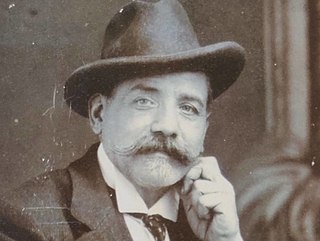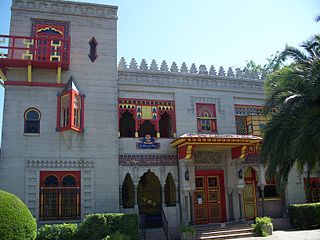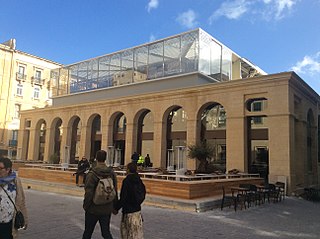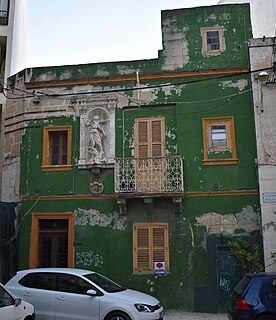
Giuseppe Calì was a Maltese painter of Italian descent.

Alhambra is a 2003 tile-based German-style board game designed by Dirk Henn. It was originally published in Germany by Queen Games in a language-interdependent version; an English-specific version was released in North America by the now-defunct Überplay. The game is an Arabian-themed update, set during the construction of the Alhambra palace in 14th century Granada, of the 1998 stock trading board game Stimmt So!, which in turn was an update of the 1992 mafia influence board game Al Capone; the original version was subsequently released as Alhambra: The Card Game.

Mediterranean Revival is an architectural style introduced in the United States in the 19th century. It incorporated references from Spanish Renaissance, Spanish Colonial, Italian Renaissance, French Colonial, Beaux-Arts, Moorish architecture, and Venetian Gothic architecture.

The NZR O class consisted of six steam locomotives that operated on New Zealand's national rail network. Ordered from the Baldwin Locomotive Works of Pennsylvania in 1885, three arrived in time to begin work in December 1885, while two more were placed in service in January 1886 and the sixth in February 1886. After almost four decades of service, all six were withdrawn in May 1922. None survived to be preserved, although two engine frames and 5 tenders from O class locomotives are known to exist near Summit on the former Rimutaka Incline.

Moorish Revival or Neo-Moorish is one of the exotic revival architectural styles that were adopted by architects of Europe and the Americas in the wake of Romanticist Orientalism. It reached the height of its popularity after the mid-19th century, part of a widening vocabulary of articulated decorative ornament drawn from historical sources beyond familiar classical and Gothic modes. Neo-Moorish architecture drew on elements from classic Moorish architecture and, as a result, from the wider Islamic architecture.

Villa Zorayda is a house at 83 King Street in St. Augustine, Florida. Built in 1883 by the eccentric Boston millionaire Franklin W. Smith as his winter home, it was inspired by the 12th-century Moorish Alhambra Palace in Granada, Spain. Smith named it "Villa Zorayda", after one of the princesses in Washington Irving's Tales of the Alhambra. The building and part of Franklin Smith's art and antique collection were sold to Abraham Mussallem, a rug and antiquities merchant originally from Syria, in 1913. On September 23, 1993, it was added to the U.S. National Register of Historic Places. The Villa Zorayda Museum is still owned by the Mussallem family and contains the original art and antique collection assembled by Franklin Smith and Abraham Mussallem.

Maltese architecture has its origins in prehistory, and some of the oldest free-standing structures on Earth – a series of megalithic temples – can be found on Malta. The islands were colonized by the Phoenicians and later the Romans, who established the cities of Melite and Gaulos. Although these were substantial settlements and are known to have had numerous temples, churches and palaces, few remains have survived apart from some architectural fragments.

Villa Guardamangia, formerly known as Casa Medina and sometimes referred to as Casa Guardamangia, is a 16,791 square feet (1,559.9 m2) townhouse in Gwardamanġa, Pietà, Malta, which served as the residence of Princess Elizabeth, Duchess of Edinburgh, and Prince Philip, Duke of Edinburgh, between 1949 and 1951, while Philip was stationed in Malta as a naval officer.

Villa Francia, initially named as Palazzo Francia, then named as Villa Preziosi, and officially known as Palazzo Francia and Francia Estate, is an 18th-century palace in Lija, Malta. The palace was built circa 1757, by Francesco Preziosi, with baroque architecture that gave a sense of pride and power to noble people at the time. The first ambitious owner became bankrupt with the expenses of the palace, to make it an outstanding building and incomparable with others, and because of this he was pressured to sell his possession by the Order of St. John to pay his accumulated debts.

Is-Suq tal-Belt, also known as the Covered Market, is a 19th-century market hall located in Valletta, Malta. It is notable for being the first building in Malta to be constructed mostly of iron. The building was severely damaged in World War II, and the rebuilding was insensitive to the original structure. Further alterations were made in later decades, and the market began to decline in the 1970s. An attempt to rebrand it as a shopping arcade known as Ixtri Malti in the 1980s was unsuccessful. The market continued to decline until it was renovated in 2016–17, and reopened as a food market in January 2018.

Emanuele Luigi Galizia was a Maltese architect and civil engineer, who designed many public buildings and several churches. He is regarded as "the principal Maltese architect throughout the second half of the nineteenth century".

Daphne Anne Caruana Galizia was a Maltese writer, journalist, blogger and anti-corruption activist, who reported on political events in Malta. In particular, she focused on investigative journalism, reporting on government corruption, nepotism, patronage, allegations of money laundering, links between Malta's online gambling industry and organized crime, Malta's citizenship-by-investment scheme, and payments from the government of Azerbaijan. Caruana Galizia's national and international reputation was built on her regular reporting of misconduct by Maltese politicians and politically exposed persons.

The Green House was a late 19th-century vernacular townhouse in Sliema, Malta. The historic residence was an icon in the area, situated at the end of St Mary Street of which name of street derives from the niche on the façade of the building. The façade was notably characterized by its dark green colour which had made it a noticeable landmark. The niche of the Assumption of Our Lady, dated to 1875, is listed on the National Inventory of the Cultural Property of the Maltese Islands (NICPMI).
Vitals Global Healthcare (VGH) is a healthcare company based in Malta. It manages Public–private partnerships and works with Barts and The London School of Medicine and Dentistry.

Villa St Ignatius is a historic villa located in the Balluta area of St Julian's, Malta. It was built in the early 19th century for the English merchant John Watson, and it might be the earliest example of Gothic Revival architecture in the country.

The Turkish Military Cemetery, also known as the Ottoman Military Cemetery, is a cemetery in Marsa, Malta. Commissioned by the Ottoman sultan Abdülaziz to replace an earlier Muslim cemetery, it was constructed between 1873 and 1874. The cemetery was designed by the Maltese architect Emanuele Luigi Galizia, and it is built in an exotic orientalist style. It is maintained by the Turkish government. Originally the cemetery was referred to as the Mahomedan Cemetery such as on documents, and also referred to as the Martyrs’ Cemetery in Turkey such as on a historic painting.

Ta' Braxia Cemetery is a cemetery in Gwardamanġa, located near the boundary between Pietà and Ħamrun, Malta. It was built between 1855 and 1857 as a multi-denomination burial ground primarily intended for British servicemen, partially replacing a number of earlier 18th century cemeteries. The site also incorporates a Jewish cemetery which was established in around 1830. The cemetery's construction was controversial since the local ecclesiastical authorities were opposed to a multi-faith extra-mural cemetery.
Yorgen Fenech is a Maltese businessman whose main interests are casinos and hotels in Malta. He was head of the Tumas Group and director of the Maltese-Azerbaijan-German company Electrogas.

An ongoing political and institutional crisis within the Republic of Malta follows the uncovering of alleged links between government officials and the 2017 assassination of investigative journalist Daphne Caruana Galizia. The Prime Minister's Chief of Staff Keith Schembri and Minister for Tourism Konrad Mizzi resigned following the arrest of businessman Yorgen Fenech in connection with the murder.

The 2019–2020 Maltese protests started in Valletta and other urban centres of Malta on 20 November 2019, mainly calling for resignations after alleged political links to the assassination of journalist and blogger Daphne Caruana Galizia surfaced following the arrest of businessman Yorgen Fenech. The protesters also targeted government corruption and the lack of action on money laundering. The protests consisted of demonstrations, marches, sit-ins, and civil disobedience and have been unprecedented in Malta's political history since its independence from the United Kingdom.
























